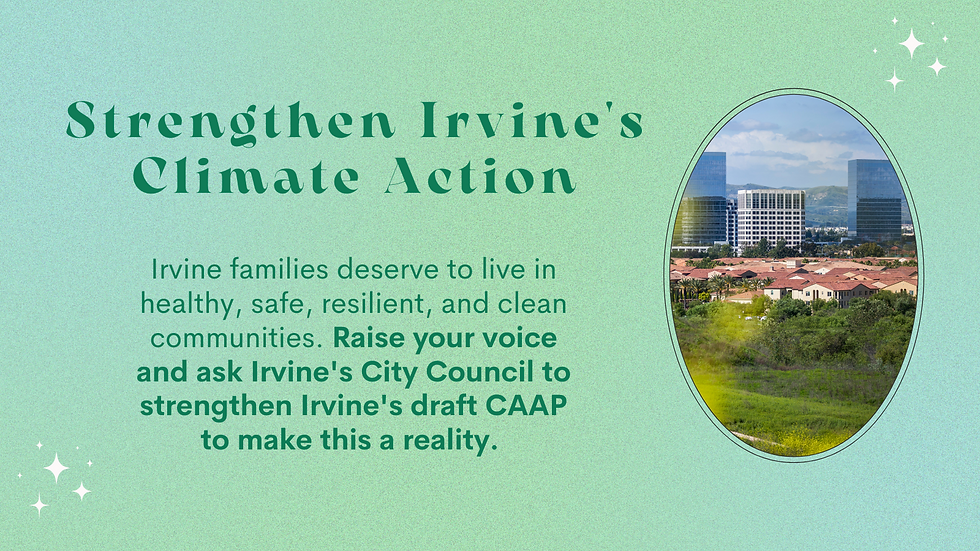Irvine released its draft Climate Action and Adaptation Plan (CAAP) this week, intended to pave the way to a zero carbon region by 2030. If the CAAP is bold and successfully implemented, it will help create the healthy, safe, resilient, and equitable communities we all deserve. However, the current draft CAAP fails to meet its ambitious goals and falls short of making this a reality.
The draft CAAP lacks key benchmarks, success metrics, and transportation goals, neglecting the urgent need to reduce vehicle miles traveled, Irvine's primary source of greenhouse gas emissions. The draft CAAP also says it won’t require new buildings to be gas-free until 2025 and plans to remove gas from less than half of existing buildings by 2045. This is not climate leadership, especially from the city that prides itself on being number 1 in fiscal strength in the U.S. with $250 million every year in unrestricted funding for city priorities.
Two years ago, Irvine set a goal of achieving zero carbon by 2030, and the CAAP should reflect that commitment. To do so, the city must strengthen the CAAP to include the following;
Mode Shift Targets
Transportation is the largest source of greenhouse gas emissions in Irvine, but the CAAP does not include mode shift targets that specify goals to shift transportation from cars to walking and biking, adding and transit. The draft CAAP says it’s counting on electric vehicles to reduce these emissions, but the California Air Resources Board Scoping Plan says the only way to significantly reduce emissions is to reduce the number of private vehicles on the road. This is also a safety issue – on average, 37 people are killed or severely injured by cars on Irvine roads each year.
The CAAP must include vehicle miles traveled reduction goals for each transportation strategy and include the creation and implementation of a Mobility Master Plan, Complete Streets Plan and Vision Zero policy to eliminate traffic injuries and deaths.
Implementation Plan with Timeline and Key Benchmarks
A plan is a great start, but needs implementation to be effective. What’s missing here are the fundamental building blocks to a gold star plan and implementation effort. Without a timeline and key benchmarks to determine success, the CAAP is merely aspirational and will likely not be implemented. To reach the ambitious goals set by the city, the CAAP needs to include success metrics for each strategy with specific timelines.
Annual Monitoring Report
Similarly, the CAAP must be paired with an annual monitoring report to ensure accountability and that metrics are met within their specified timelines. This means that every year, Irvine residents deserve to know how and when tangible change is being brought to their communities.
Create a Pathway to 2030 Zero Carbon
In alignment with Irvine’s stated commitment to zero carbon by 2030, the CAAP needs to create shorter timelines for key strategies and actions. By accelerating the implementation of these actions, Irvine can effectively address the urgent need to reduce emissions and advance sustainability goals.
CEQA Checklist
The CAAP should follow California Environmental Quality Act (CEQA) regulations. CEQA requires the development of Environmental Impact Reports before developing new construction. The best CAPs are legally binding and enforceable under state law, meaning they mandate greenhouse gas reductions in exchange for allowing new residential and commercial projects to be streamlined for faster approval under CEQA.
Gas-Free Buildings
The draft CAAP also says it won’t require new buildings to be gas-free until 2025 and will remove gas from less than half of existing buildings by 2045. This is not climate leadership.
A strong CAAP can provide a concrete strategy for mitigating the effects of climate change and protecting the health and safety of residents. By adopting a bold CAAP, Irvine can access state and federal funding to invest in renewable energy, green infrastructure, and equity-centered solutions.
Together, we can ensure that Irvine residents have access to clean air, clean water, and a healthy and safe future. Raise your voice and support stronger timelines, transparency, and emission reduction goals. Email Irvine’s City Council today to support a strong CAAP and equitable and sustainable communities.
Want to support in person? Use our toolkit and join us on June 27th!


Comments